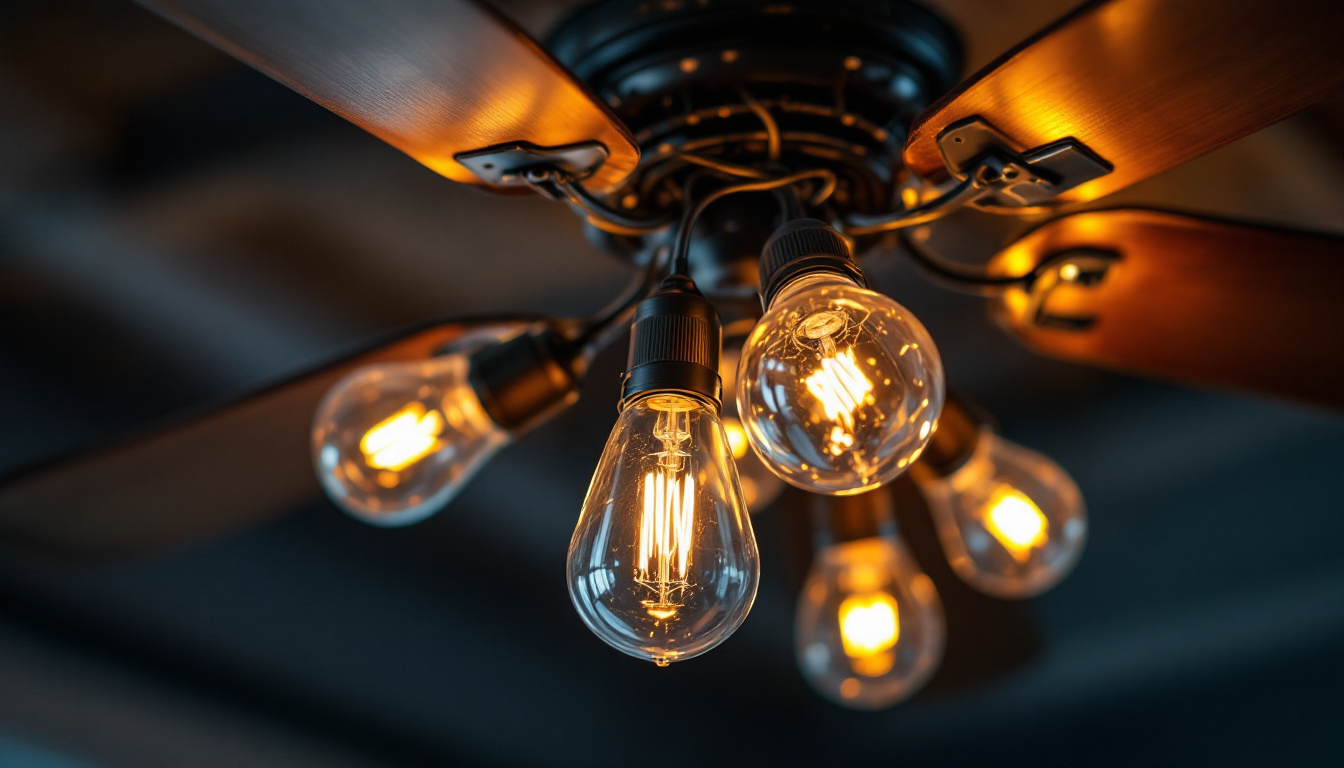

Ceiling fans are a staple in many homes and commercial spaces, providing both comfort and aesthetic appeal. For lighting contractors, understanding the various parts of a ceiling fan light is essential for installation, maintenance, and repair. This article delves into the key components of ceiling fan lights, highlighting their significance and the reasons every lighting contractor should be well-versed in these parts.
Ceiling fan lights are not just simple fixtures; they consist of several intricate components that work together to provide illumination and airflow. Familiarity with these parts can enhance a contractor’s ability to troubleshoot issues and offer better service to clients.
The light kit is the component that houses the bulbs and is typically attached to the bottom of the fan. It can come in various styles and designs, allowing contractors to match the aesthetic of the fan with the overall decor of the space. Understanding the different types of light kits available, such as integrated LED kits or traditional bulb sockets, is crucial for making informed recommendations to clients.
Moreover, the light kit’s design can affect the brightness and ambiance of the room. Lighting contractors should be aware of the wattage limits and bulb compatibility to ensure optimal performance and safety. Additionally, some light kits come with features like dimming capabilities or color-changing options, which can greatly enhance the versatility of a ceiling fan light. By educating clients on these advanced features, contractors can help them create a customized lighting experience that suits their lifestyle and preferences.
Bulbs are the heart of the light kit, providing the necessary illumination. Various types of bulbs can be used in ceiling fan lights, including incandescent, CFL, and LED. Each type has its own advantages and disadvantages, such as energy efficiency, brightness, and longevity. Lighting contractors must be knowledgeable about these differences to guide clients in selecting the best option for their specific needs.
Additionally, understanding the color temperature of bulbs can help contractors create the desired atmosphere. For instance, warm white bulbs can create a cozy environment, while cool white bulbs are ideal for task-oriented spaces. Furthermore, the lumens output of a bulb plays a crucial role in determining how well a room is lit. Contractors should be prepared to explain to clients how higher lumen counts can provide brighter lighting, which is particularly beneficial in larger rooms or areas with high ceilings.
Switches and controls are essential for operating the ceiling fan light. They can range from simple pull chains to sophisticated remote controls and wall switches. Familiarity with the various control options allows contractors to offer clients the best solutions for convenience and functionality.
Moreover, understanding how to install and troubleshoot these controls can save time and enhance customer satisfaction. For example, knowing how to pair a remote control with a fan can prevent frustration during installation. Some modern ceiling fans also come equipped with smart technology, allowing them to be controlled via smartphone apps or voice-activated systems. Contractors should stay updated on these innovations, as they can significantly improve user experience and appeal to tech-savvy clients looking for seamless integration into their smart home systems.
Electrical components are crucial for the operation of ceiling fan lights. A solid grasp of these elements is vital for any lighting contractor aiming to provide safe and effective installations.
The wiring in a ceiling fan light connects the electrical supply to the fan and light kit. Proper wiring is essential for ensuring safety and functionality. Lighting contractors must be familiar with the different wiring configurations and codes to avoid potential hazards.
Additionally, understanding how to troubleshoot wiring issues can help contractors quickly resolve problems, ensuring client satisfaction and safety. For example, knowing how to identify loose connections or faulty wiring can prevent future electrical issues. Furthermore, contractors should also be aware of the different types of wires, such as copper and aluminum, and their respective advantages and disadvantages. Copper, for instance, is more conductive and durable, making it a preferred choice for many installations, while aluminum is lighter and less expensive but may require larger gauge sizes to carry the same current safely.
Capacitors play a vital role in the operation of ceiling fans, particularly in regulating the fan speed and providing power to the light kit. A contractor’s knowledge of capacitors can be beneficial when diagnosing performance issues or when a fan is not operating as expected.
Recognizing the symptoms of capacitor failure, such as inconsistent fan speeds or flickering lights, allows contractors to address problems promptly, ensuring the fan operates efficiently and effectively. Moreover, understanding the different types of capacitors, such as run capacitors and start capacitors, can aid in selecting the right replacement part when needed. Run capacitors, for example, are crucial for the continuous operation of the fan motor, while start capacitors provide the necessary boost to initiate the fan’s movement, making it essential for contractors to know which type is appropriate for each specific fan model.
Pull chains and cords are often overlooked components, yet they are essential for controlling the fan and light. Understanding how these mechanisms work can help contractors provide better service, especially when clients experience issues with their operation.
For instance, knowing how to replace a broken pull chain or adjust the length of a pull cord can enhance a contractor’s service offerings. Additionally, educating clients on proper usage can prolong the lifespan of these components. It’s also important to consider the aesthetic aspects of pull chains and cords; many homeowners appreciate decorative options that match their interior design. Offering a variety of styles and materials can not only improve functionality but also add a personalized touch to the installation, making it more appealing to clients. Furthermore, contractors should inform clients about alternative control options, such as remote controls or wall switches, which can enhance convenience and accessibility, especially in larger rooms where reaching the pull chain may be cumbersome.
Proper installation is crucial for the longevity and performance of ceiling fan lights. Lighting contractors should adhere to best practices to ensure a successful setup.
Choosing the right location and height for a ceiling fan is essential for optimal airflow and lighting. Contractors should consider the size of the room, the height of the ceiling, and the placement of furniture when installing a fan. A fan installed too low may obstruct movement, while one installed too high may not provide adequate airflow.
Furthermore, ensuring that the fan is centered in the room can enhance both functionality and aesthetics. Contractors should also be aware of local building codes regarding ceiling fan installation to ensure compliance.
The mounting bracket is the foundation of a ceiling fan installation. Properly securing the bracket to a ceiling joist or support beam is vital for safety and stability. Contractors should use appropriate hardware and follow manufacturer guidelines to ensure a secure installation.
Additionally, checking for any signs of wear or damage to the mounting bracket during installation can prevent future issues. A well-secured fan will operate more efficiently and reduce the risk of accidents.
Unbalanced fan blades can lead to noise, wobbling, and premature wear on the motor. Lighting contractors should take the time to balance the blades during installation to ensure smooth operation. This may involve adjusting the blade pitch or using balancing kits provided by the manufacturer.
Educating clients about the importance of maintaining balanced blades can also enhance their overall satisfaction with the installation. A well-balanced fan not only operates more quietly but also extends the lifespan of the fan components.
Regular maintenance is key to ensuring the longevity and efficiency of ceiling fan lights. Lighting contractors should be prepared to offer maintenance tips and troubleshooting advice to clients.
Ceiling fans can accumulate dust and debris over time, which can affect their performance and appearance. Contractors should advise clients on the best cleaning practices, such as using a microfiber cloth or a fan duster to clean the blades and light kit regularly.
Additionally, educating clients on the importance of cleaning can help prevent issues like reduced airflow and flickering lights caused by dust buildup. Establishing a regular cleaning schedule can enhance the fan’s performance and prolong its lifespan.
Flickering lights can be a common issue with ceiling fan lights, often caused by loose connections, faulty bulbs, or electrical problems. Lighting contractors should be equipped to diagnose these issues effectively.
For example, checking the bulb connections and replacing faulty bulbs can often resolve flickering. If the problem persists, examining the wiring and switches may be necessary to identify underlying electrical issues.
The motor is the heart of the ceiling fan, and proper maintenance is essential for its longevity. Contractors should advise clients on how to lubricate the motor and check for signs of wear or overheating.
Regular motor maintenance can prevent issues such as reduced airflow or unusual noises, ensuring that the fan operates smoothly. Educating clients about the signs of motor problems can help them seek timely assistance, preventing more significant issues down the line.
Understanding the various parts of a ceiling fan light is essential for lighting contractors. From the light kit and bulbs to the electrical components and installation practices, each element plays a crucial role in the overall performance and satisfaction of the client.
By familiarizing themselves with these components and best practices, contractors can provide superior service, troubleshoot effectively, and educate clients on maintenance. In a competitive market, this knowledge can set a contractor apart, ensuring long-lasting relationships with clients and a reputation for excellence.
Ultimately, a well-installed and maintained ceiling fan light not only enhances the functionality of a space but also contributes to the overall comfort and aesthetic appeal. For lighting contractors, mastering the parts of a ceiling fan light is not just beneficial; it is essential for success in the industry.
Ready to elevate your lighting projects with the best parts and accessories? Look no further than LumenWholesale, where we offer an extensive selection of top-quality, spec-grade lighting products at unbeatable wholesale prices. Say goodbye to inflated markups and hello to superior lighting that meets the highest industry standards. With free shipping on bulk orders, LumenWholesale is your go-to source for premium lighting without the hidden fees. Don’t compromise on quality or value—Wholesale Lighting at the Best Value is just a click away. Enhance your service offerings and delight your clients with the perfect blend of quality, affordability, and convenience today!

Discover how choosing the right power cords can significantly cut expenses for lighting contractors.

Discover the top five reasons why lighting contractors should prioritize different types of fluorescent lights.

Discover essential insights for lighting contractors with our comprehensive guide on ceiling lights.

Discover how motion lights for outside are revolutionizing modern lighting solutions by enhancing security, energy efficiency, and aesthetic appeal.
Get notified when NEW deals are released.
Optimize your budget with wholesale discounts.
Only top-quality, specification-grade lighting products.
No additional costs at checkout - what you see is what you pay.
We understand the unique needs of contractors.